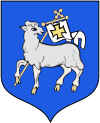Koprzywnica
| Koprzywnica | ||
|---|---|---|
|
Saint Florian Church | ||
| ||
 Koprzywnica | ||
| Coordinates: 50°35′26″N 21°35′1″E / 50.59056°N 21.58361°E | ||
| Country |
| |
| Voivodeship | Świętokrzyskie | |
| County | Sandomierz | |
| Gmina | Koprzywnica | |
| Area | ||
| • Total | 17.9 km2 (6.9 sq mi) | |
| Population (2006) | ||
| • Total | 2,531 | |
| • Density | 140/km2 (370/sq mi) | |
| Postal code | 27-660 | |
| Area code(s) | +48 15 | |
| Car plates | TSA | |
| Website | http://www.koprzywnica.eu/ | |
Koprzywnica [kɔpʂɨvˈɲit͡sa] is a town in Sandomierz County, Świętokrzyskie Voivodeship, Poland, with 2,546 inhabitants (2004). Koprzywnica lies on the Koprzywianka river, in Lesser Poland. It is one of the oldest urban centers of the province, located along the Tarnobrzeg Route of historic Lesser Polish Way of St. James, and on the National Road Nr. 79, which goes from Kraków to Sandomierz.
The settlement of Koprzywnica already existed at the beginning of the 12th century, and at that time was called Pokrzywnica. In 1185, Prince Casimir II the Just brought here the Cistercians, and in the same year, local nobleman Mikołaj Bogoria Skotnicki of Bogorya coat of arms presented Koprzywnica to the monks, together with several villages in the area. By order of the Duke of Sandomierz, Bolesław V the Chaste, Koprzywnica was granted town rights (see Magdeburg Rights), on December 8, 1268. Due to the presence of the Cistercians, Koprzywnica prospered, and from the 14th to the 17th century it was among medium-sized towns of Lesser Poland. In 1606, it was one of the centers of a rokosz (armed rebellion) of the nobility against King Zygmunt III Waza, organized by Mikołaj Zebrzydowski. In 1655 - 1660 Koprzywnica was destroyed during the Swedish invasion of Poland. The town never recovered from the loses, and in 1869 Russian authorities of Congress Poland reduced it to the status of a village. Koprzywnica became a town again on January 1, 2001.
Koprzywnica's ghetto was liquidated by the Nazis on 31 October 1942, when 1,800 Jews from the ghetto were transferred to the Treblinka concentration camp and slaughtered. Some Jews that returned to Koprzywnica were murdered by Poles.
Among points of interest are:
- Cistercian church of St. Florian (13th century, destroyed in the Mongol invasion of Poland in 1241, rebuilt and remodeled in the 15th and 18th centuries)
- eastern wing of a former Cistercian monastery (13th century)
- market square with St. Mary of Rosary church (1470)
References
Coordinates: 50°35′N 21°35′E / 50.583°N 21.583°E

